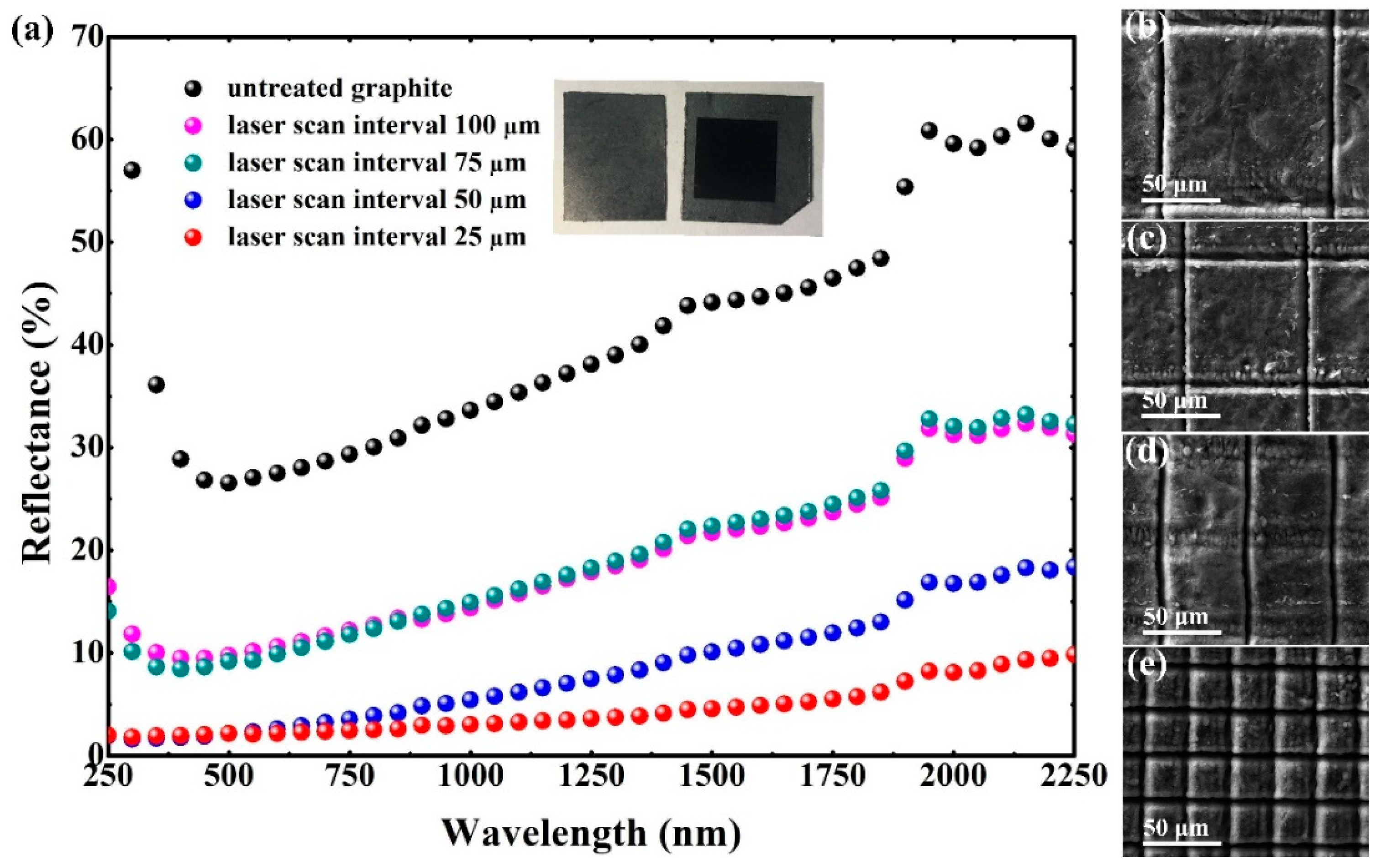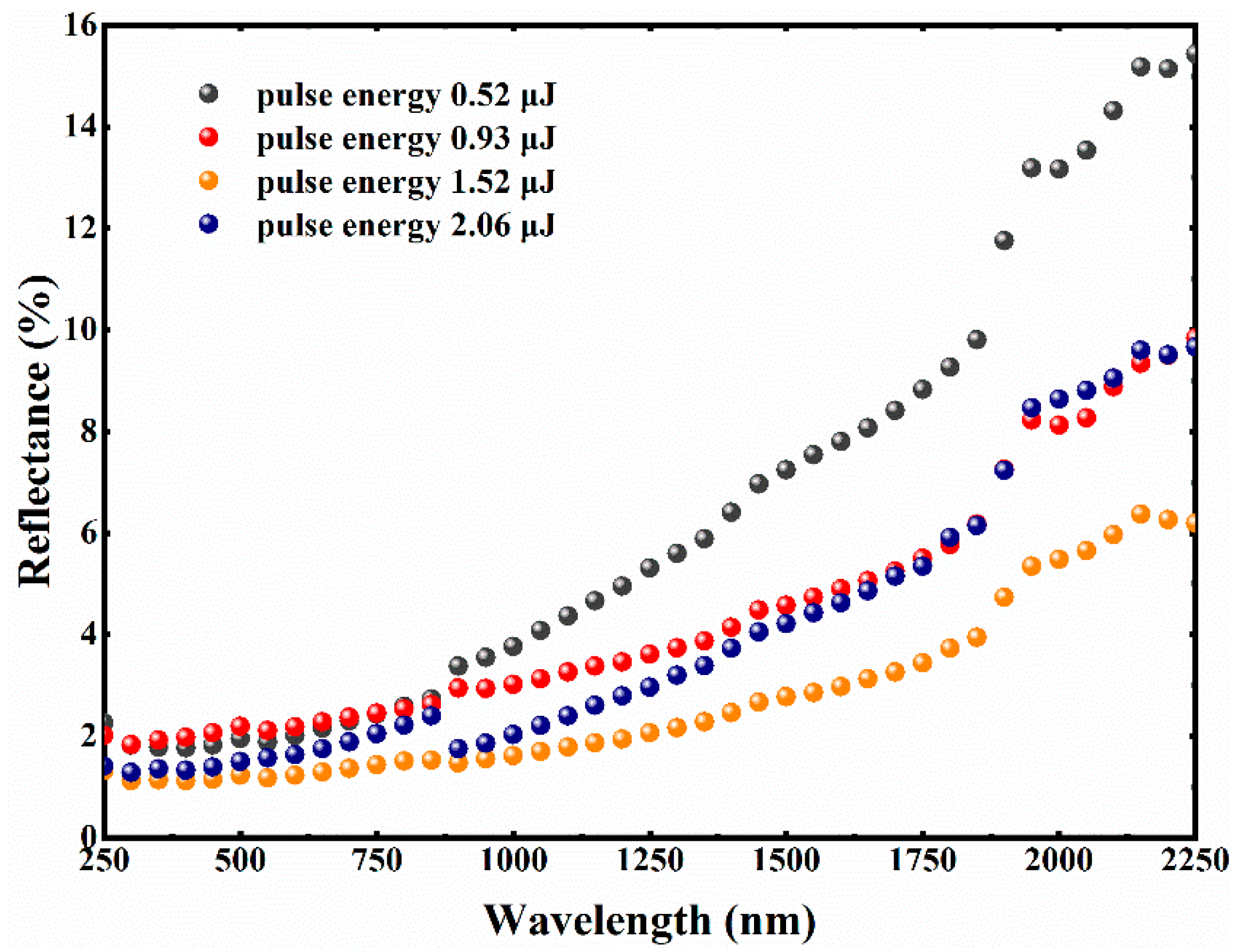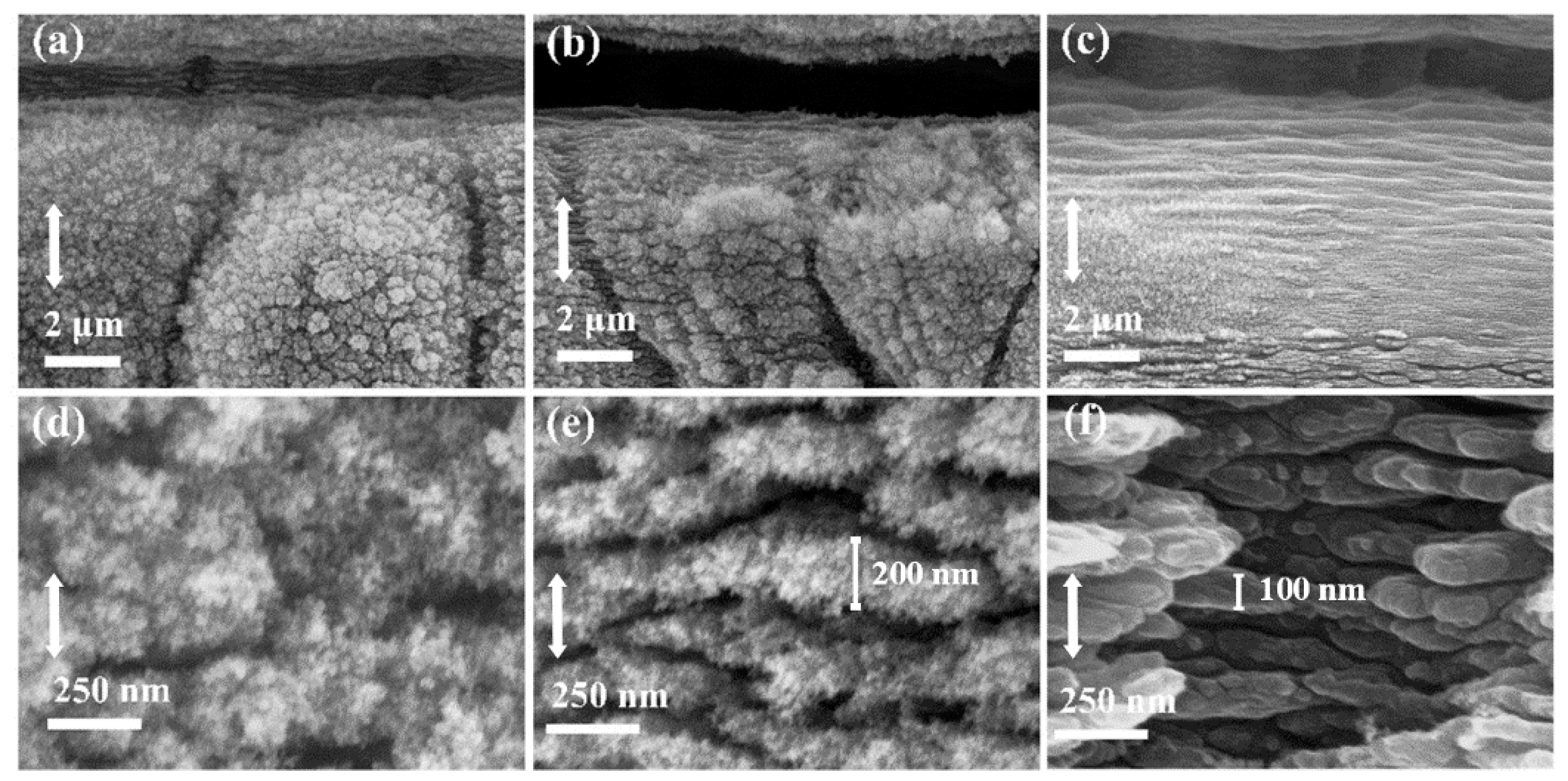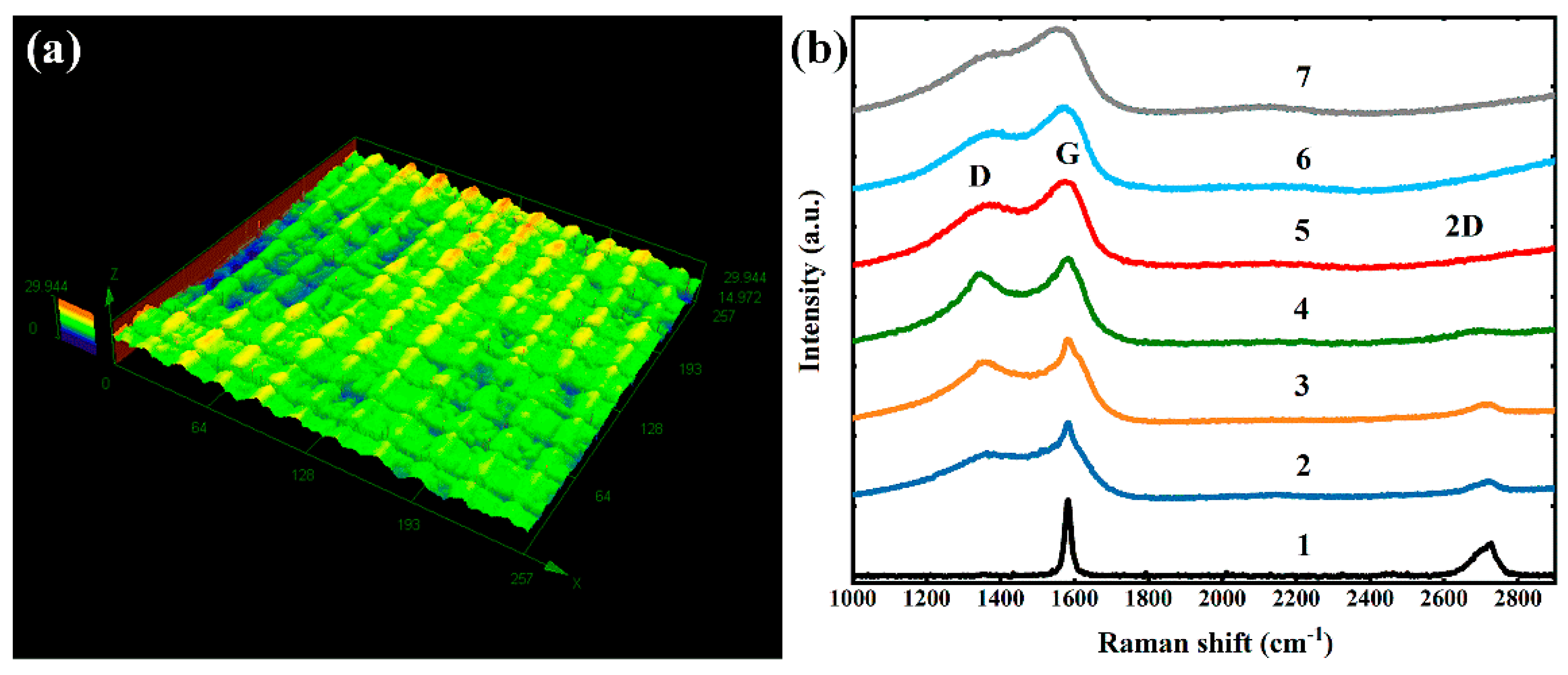Antireflective and Superhydrophilic Structure on Graphite Written by Femtosecond Laser
Abstract
:1. Introduction
2. Experimental
2.1. Materials
2.2. Fabrication of Functional Surface
2.3. Characterization and Measurement
3. Results and Discussion
3.1. Surface Reflectance
3.2. Surface Wettability
3.3. Raman and XPS Analysis
4. Conclusions
Author Contributions
Funding
Conflicts of Interest
References
- Raut, H.K.; Ganesh, V.A.; Ramakrishna, S. Antireflective coatings: A critical, in-depth review. Energy Environ. Sci. 2011, 4, 3779–3804. [Google Scholar] [CrossRef]
- Song, T.; Lee, S.-T.; Sun, B. Silicon nanowires for photovoltaic applications: The progress and challenge. Nano Energy 2012, 1, 654–673. [Google Scholar] [CrossRef]
- Lehman, J.; Sanders, A.; Hanssen, L.; Wilthan, B.; Zeng, J.; Jensen, C. Very Black Infrared Detector from Vertically Aligned Carbon Nanotubes and Electric-Field Poling of Lithium Tantalate. Nano Lett. 2010, 10, 3261–3266. [Google Scholar] [CrossRef] [PubMed]
- Landy, N.I.; Sajuyigbe, S.; Mock, J.J.; Smith, D.R.; Padilla, W.J. Perfect Metamaterial Absorber. Phys. Rev. Lett. 2008, 100, 207402. [Google Scholar] [CrossRef] [PubMed]
- Schmitt, N.; Tessier, L.; Patat, F.; Chovelon, J.M.; Martelet, C. Analysis of the influence of the surface wettability on the quartz sensor response. Sens. Actuators A Phys. 1995, 47, 357–363. [Google Scholar] [CrossRef]
- Kim, J.Y.; Choi, K.; Moon, D.; Ahn, J.H.; Park, T.J.; Lee, S.Y.; Choi, Y.K. Surface engineering for enhancement of sensitivity in an underlap-FET biosensor by control of wettability. Biosens. Bioelectron. 2013, 41, 867–870. [Google Scholar] [CrossRef] [PubMed]
- Han, J.T.; Lee, D.H.; Ryu, C.Y.; Cho, K. Fabrication of superhydrophobic surface from a supramolecular organosilane with quadruple hydrogen bonding. J. Am. Chem. Soc. 2004, 126, 4796–4797. [Google Scholar] [CrossRef]
- White, J.M.; Szanyi, J.; Henderson, M.A. The Photon-Driven Hydrophilicity of Titania: A Model Study Using TiO2(110) and Adsorbed Trimethyl Acetate. J. Phys. Chem. B 2003, 107, 9029–9033. [Google Scholar] [CrossRef]
- Folgueras, L.C.; Alves, M.A.; Rezende, M.C. Evaluation of a nanostructured microwave absorbent coating applied to a glass fiber/polyphenylene sulfide laminated composite. Mater. Res. 2014, 17, 197–202. [Google Scholar] [CrossRef] [Green Version]
- Divochiy, A.; Marsili, F.; Bitauld, D.; Gaggero, A.; Leoni, R.; Mattioli, F.; Korneev, A.; Seleznev, V.; Kaurova, N.; Minaeva, O.; et al. A Fiore, Superconducting nanowire photon-number-resolving detector at telecommunication wavelengths. Nat. Photonics 2008, 2, 302–306. [Google Scholar] [CrossRef] [Green Version]
- Weickert, J.; Dunbar, R.B.; Hesse, H.C.; Wiedemann, W.; Schmidt-Mende, L. Nanostructured Organic and Hybrid Solar Cells. Adv. Mater. 2011, 23, 1810–1828. [Google Scholar] [CrossRef]
- Vorobyev, A.Y.; Guo, C. Multifunctional surfaces produced by femtosecond laser pulses. J. Appl. Phys. 2015, 117, 137–171. [Google Scholar] [CrossRef] [Green Version]
- Zhou, W.; Tao, M.; Chen, L.; Yang, H. Microstructured surface design for omnidirectional antireflection coatings on solar cells. J. Appl. Phys. 2007, 102, 103105. [Google Scholar] [CrossRef] [Green Version]
- Chindam, C.; Wonderling, N.M.; Lakhtakia, A.; Awadelkarim, O.O.; Orfali, W. Microfiber inclination, crystallinity, and water wettability of microfibrous thin-film substrates of Parylene C in relation to the direction of the monomer vapor during fabrication. Appl. Surf. Sci. 2015, 345, 145–155. [Google Scholar] [CrossRef]
- Panek, P.; Lipiński, M.; Dutkiewicz, J. Texturization of multicrystalline silicon by wet chemical etching for silicon solar cells. J. Mater. Sci. 2005, 40, 1459–1463. [Google Scholar] [CrossRef]
- Shibuichi, S.; Yamamoto, T.; Onda, T.; Tsujii, K. Super Water- and Oil-Repellent Surfaces Resulting from Fractal Structure. J. Colloid Interface Sci. 1998, 208, 287–294. [Google Scholar] [CrossRef]
- Dudem, B.; Leem, J.W.; Yu, J.S. A multifunctional hierarchical nano/micro-structured silicon surface with omnidirectional antireflection and superhydrophilicity via an anodic aluminum oxide etch mask. RSC Adv. 2016, 6, 3764–3773. [Google Scholar] [CrossRef]
- Shiu, J.; Kuo, C.; Chen, P.; Mou, C.Y. Fabrication of Tunable Superhydrophobic Surfaces by Nanosphere Lithography. Chem. Mater. 2004, 16, 561–564. [Google Scholar] [CrossRef]
- Hoyo, J.D.; Vazquez, R.M.; Sotillo, B.; Fernandez, T.T.; Siegel, J.; Fernández, P.; Osellame, R.; Solis, J. Control of waveguide properties by tuning femtosecond laser induced compositional changes. Appl. Phys. Lett. 2014, 105, 131101. [Google Scholar] [CrossRef] [Green Version]
- Vorobyev, A.Y.; Chunlei, G. Femtosecond laser nanostructuring of metals. Opt. Express 2006, 14, 2164–2169. [Google Scholar] [CrossRef]
- Zhang, G.; Stoian, R.; Zhao, W.; Cheng, G. Femtosecond laser Bessel beam welding of transparent to non-transparent materials with large focal-position tolerant zone. Opt. Express 2018, 26, 917–926. [Google Scholar] [CrossRef] [PubMed]
- Nivas, J.J.J.; He, S.; Anoop, K.K.; Rubano, A.; Fittipaldi, R.; Vecchione, A.; Paparo, D.; Marrucci, L.; Bruzzese, R.; Amoruso, S. Laser ablation of silicon induced by a femtosecond optical vortex beam. Opt. Lett. 2015, 40, 4611–4614. [Google Scholar] [CrossRef] [PubMed]
- Li, B.; Huang, L.; Ren, N.; Kong, X. Laser ablation processing of zinc sheets in hydrogen peroxide solution for preparing hydrophobic microstructured surfaces. Mater. Lett. 2015, 164, 384–387. [Google Scholar] [CrossRef]
- Zhan, H.; Shi, Q.; Wu, G.; Wang, J. Construction of Carbon Nanotube Sponges to Have High Optical Antireflection and Mechanical Stability. ACS Appl. Mater. Interfaces 2020, 12, 21424. [Google Scholar] [CrossRef] [PubMed]
- Liu, J.; Liu, H.; Lin, N.; Xie, Y.; Bai, S.; Lin, Z.; Lu, L.; Tang, Y. Facile fabrication of super-hydrophilic porous graphene with ultra-fast spreading feature and capillary effect by direct laser writing. Mater. Chem. Phys. 2020, 20, 30457. [Google Scholar] [CrossRef]
- Kato, R.; Hasegawa, M. Controlled defect formation and heteroatom doping in monolayer graphene using active oxygen species under ultraviolet irradiation. Carbon 2021, 171, 55–61. [Google Scholar] [CrossRef]
- Bonaccorso, F.; Sun, Z.; Hasan, T.; Ferrari, A.C. Graphene photonics and optoelectronics. Nat. Photonics 2010, 4, 611–622. [Google Scholar] [CrossRef] [Green Version]
- Surwade, S.P.; Smirnov, S.N.; Vlassiouk, I.V.; Unocic, R.R.; Veith, G.M.; Dai, S.; Mahurin, S.M. Water desalination using nanoporous single-layer graphene. Nat. Nanotechnol. 2015, 10, 459–464. [Google Scholar] [CrossRef] [PubMed]
- Drogowska-Horna, K.A.; Mirza, I.; Rodriguez, A.; Kovarícek, P.; Sládek, J.; Derrien, J.Y.; Gedvilas, M.; Raciukaitis, G.; Frank, O.; Bulgakova, N.M. Periodic surface functional group density on graphene via laser-induced substrate patterning at Si/SiO2 interface. Nano Res. 2020, 13, 2332–2339. [Google Scholar] [CrossRef]
- Giannuzzi, G.; Gaudiuso, C.; Mundo, R.D.; Mirenghi, L.; Fraggelakis, F.; Kling, R.; Lugara, P.M.; Ancona, A. Short and long term surface chemistry and wetting behaviour of stainless steel with 1D and 2D periodic structures induced by bursts of femtosecond laser pulses. Appl. Surf. Sci. 2019, 494, 1055–1065. [Google Scholar] [CrossRef]
- Yoon, H.J.; Jun, D.H.; Yang, J.H.; Zhou, Z.; Yang, S.S.; Cheng, M.C. Carbon dioxide gas sensor using a graphene sheet. Sens. Actuators B Chem. 2011, 157, 310–313. [Google Scholar] [CrossRef]
- Wang, J.; Mu, X.; Sun, M.; Mu, T. Optoelectronic properties and applications of graphene-based hybrid nanomaterials and van der Waals heterostructures. Appl. Mater. Today 2019, 16, 1–20. [Google Scholar] [CrossRef]
- Li, C.L.; Zang, Z.G.; Chen, W.W.; Hu, Z.P.; Tang, X.S.; Hu, W.; Sun, K.; Liu, X.M.; Chen, W.M. Highly pure green light emission of perovskite CsPbBr3 quantum dots and their application for green light-emitting diodes. Opt. Express 2016, 24, 15071–15078. [Google Scholar] [CrossRef] [PubMed]
- Low, T.; Avouris, P. Graphene plasmonics for terahertz to mid-infrared applications. ACS Nano 2014, 8, 1086–1101. [Google Scholar] [CrossRef] [PubMed] [Green Version]
- Yin, Z.; Zhu, J.; He, Q.; Cao, X.; Tan, C.; Chen, H.; Yan, Q.; Hua, Z. Graphene-Based Materials for Solar Cell Applications. Adv. Energy Mater. 2014, 4, 1–19. [Google Scholar] [CrossRef]
- Mancuso, M.; Beeman, J.W.; Giuliani, A.; Dumoulin, L.; Olivieri, E.; Pessina, G.; Plantevin, O.; Rusconi, C.; Tenconi, M. An experimental study of antireflective coatings in Ge light detectors for scintillating bolometers. EPJ Web Conf. 2014, 65, 1–4. [Google Scholar] [CrossRef] [Green Version]
- Cai, J.; Qi, L. Recent advances in antireflective surfaces based on nanostructure arrays. Mater. Horiz. 2014, 2, 37–53. [Google Scholar] [CrossRef]
- Bulgakova, N.M.; Bulgakov, A.V.; Bourakov, I.M.; Bulgakova, N.A. Pulsed laser ablation of solids and critical phenomena. Appl. Surf. Sci. 2002, 197, 96–99. [Google Scholar] [CrossRef]
- Derrien, T.J.Y.; Itina, T.E.; Torres, R.; Sarnet, T.; Sentis, M. Possible surface plasmon polariton excitation under femtosecond laser irradiation of silicon. J. Appl. Phys. 2013, 114, 083104. [Google Scholar] [CrossRef]
- Derrien, T.J.Y.; Kruger, J.; Itina, T.E.; Hohm, S.; Rosenfeld, A.; Bonse, J. Rippled area formed by surface plasmon polaritons upon femtosecond laser double-pulse irradiation of silicon: The role of carrier generation and relaxation processes. Appl. Phys. A 2013, 117, 77–81. [Google Scholar] [CrossRef] [Green Version]
- Rudenko, A.; Colombier, J.P.; Itina, T.E. From random inhomogeneities to periodic nanostructures induced in bulk silica by ultrashort laser. Phys. Rev. B 2016, 93, 075427. [Google Scholar] [CrossRef] [Green Version]
- Levy, Y.; Derrien, T.J.Y.; Bulgakova, N.M.; Gurevich, E.L.; Mocek, T. Relaxation dynamics of femtosecond-laser-induced temperature modulation on the surfaces of metals and semiconductors. Appl. Surf. Sci. 2016, 374, 157–164. [Google Scholar] [CrossRef]
- Saikiran, V.; Dar, M.H.; Rao, D.N. Femtosecond laser induced nanostructuring of graphite for the fabrication of quasi-periodic nanogratings and novel carbon nanostructures. Appl. Surf. Sci. 2018, 428, 177–185. [Google Scholar] [CrossRef]
- Lou, R.; Zhang, G.; Li, G.; Li, X.; Liu, Q.; Cheng, G. Design and fabrication of dual-scale broadband antireflective structures on metal surfaces by using nanosecond and femtosecond lasers. Micromachines 2020, 11, 1–11. [Google Scholar] [CrossRef] [Green Version]
- Song, Z.; Guo, F.; Liu, Y.; Hu, S.; Liu, X.; Wang, Y. Controllable bidirectional wettability transition of impregnated graphite by laser treatment and transition mechanism analysis. Surf. Coat. Technol. 2017, 317, 95–102. [Google Scholar] [CrossRef]
- Wenzel, R.N. Surface Roughness and Contact Angle. J. Phys. Colloid Chem. 1948, 53, 1466–1467. [Google Scholar] [CrossRef]
- Ferrari, A.C. Raman spectroscopy of graphene and graphite: Disorder, electron-phonon coupling, doping and nonadiabatic effects. Solid State Commun. 2007, 143, 47–57. [Google Scholar] [CrossRef]
- Ferrari, A.C.; Robertson, J. Resonant Raman spectroscopy of disordered, amorphous, and diamondlike carbon. Phys. Rev. B 2001, 64, 075414. [Google Scholar] [CrossRef] [Green Version]
- Ferrari, A.C.; Meyer, J.C.; Scardaci, V.; Casiraghi, C.; Lazzeri, M.; Mauri, F.; Piscanec, S.; Jiang, D.; Novoselov, K.S.; Roth, S.; et al. Raman Spectrum of Graphene and Graphene Layers. Phys. Rev. Lett. 2006, 97, 187401. [Google Scholar] [CrossRef] [Green Version]
- Eckmann, A.; Felten, A.; Mishchenko, A.; Britnell, L.; Krupke, R.; Novoselov, K.S.; Casiraghi, C. Probing the nature of defects in graphene by Raman spectroscopy. Nano Lett. 2012, 12, 3925–3930. [Google Scholar] [CrossRef] [Green Version]







Publisher’s Note: MDPI stays neutral with regard to jurisdictional claims in published maps and institutional affiliations. |
© 2021 by the authors. Licensee MDPI, Basel, Switzerland. This article is an open access article distributed under the terms and conditions of the Creative Commons Attribution (CC BY) license (http://creativecommons.org/licenses/by/4.0/).
Share and Cite
Lou, R.; Li, G.; Wang, X.; Zhang, W.; Wang, Y.; Zhang, G.; Wang, J.; Cheng, G. Antireflective and Superhydrophilic Structure on Graphite Written by Femtosecond Laser. Micromachines 2021, 12, 236. https://doi.org/10.3390/mi12030236
Lou R, Li G, Wang X, Zhang W, Wang Y, Zhang G, Wang J, Cheng G. Antireflective and Superhydrophilic Structure on Graphite Written by Femtosecond Laser. Micromachines. 2021; 12(3):236. https://doi.org/10.3390/mi12030236
Chicago/Turabian StyleLou, Rui, Guangying Li, Xu Wang, Wenfu Zhang, Yishan Wang, Guodong Zhang, Jiang Wang, and Guanghua Cheng. 2021. "Antireflective and Superhydrophilic Structure on Graphite Written by Femtosecond Laser" Micromachines 12, no. 3: 236. https://doi.org/10.3390/mi12030236
APA StyleLou, R., Li, G., Wang, X., Zhang, W., Wang, Y., Zhang, G., Wang, J., & Cheng, G. (2021). Antireflective and Superhydrophilic Structure on Graphite Written by Femtosecond Laser. Micromachines, 12(3), 236. https://doi.org/10.3390/mi12030236




